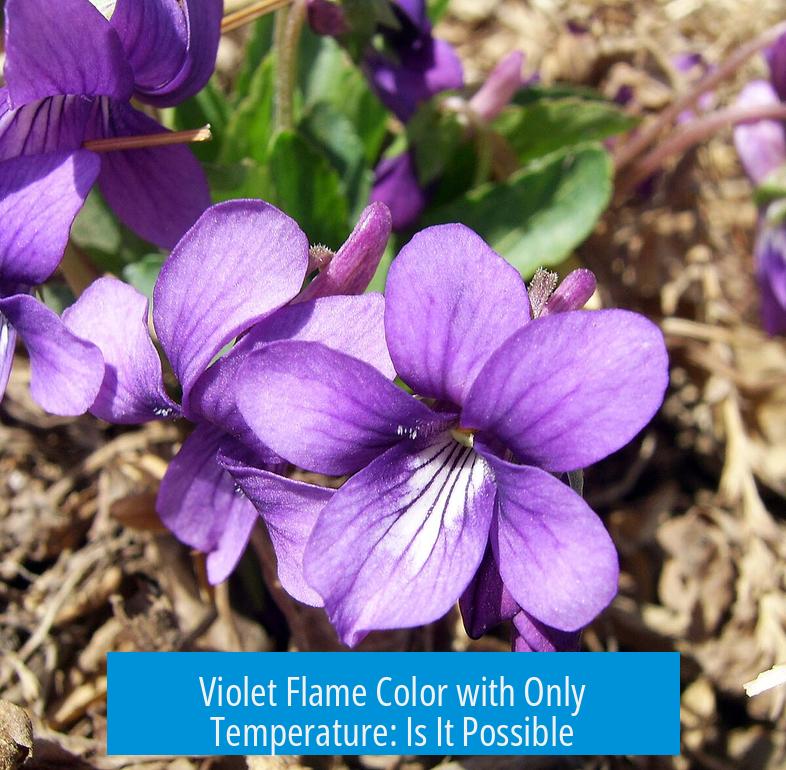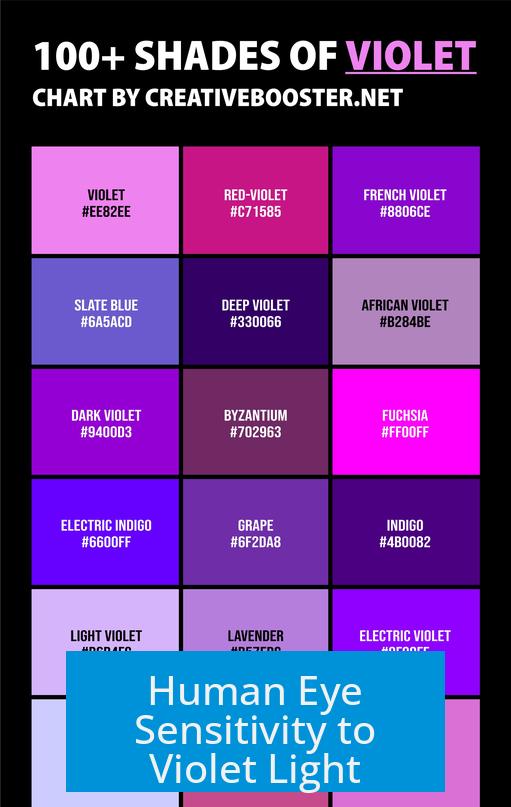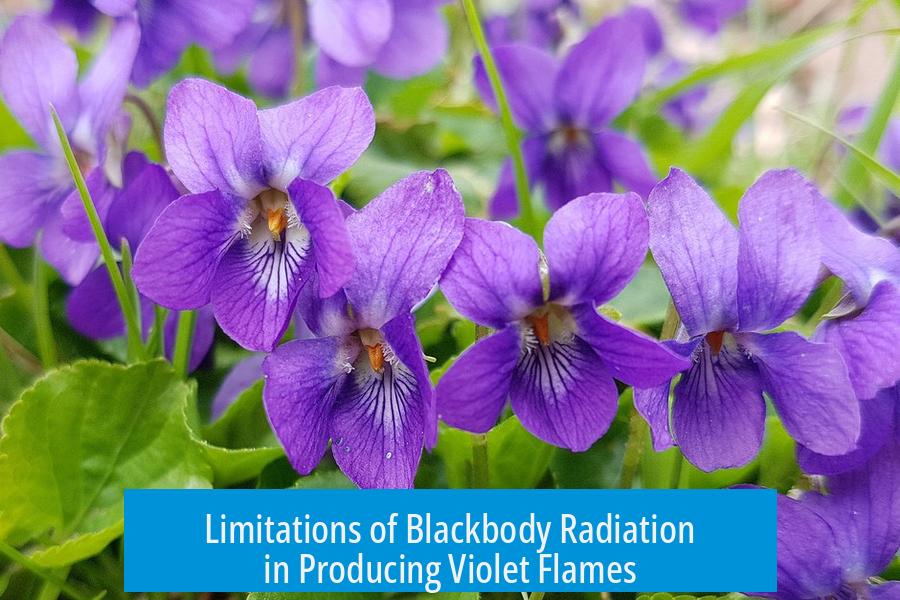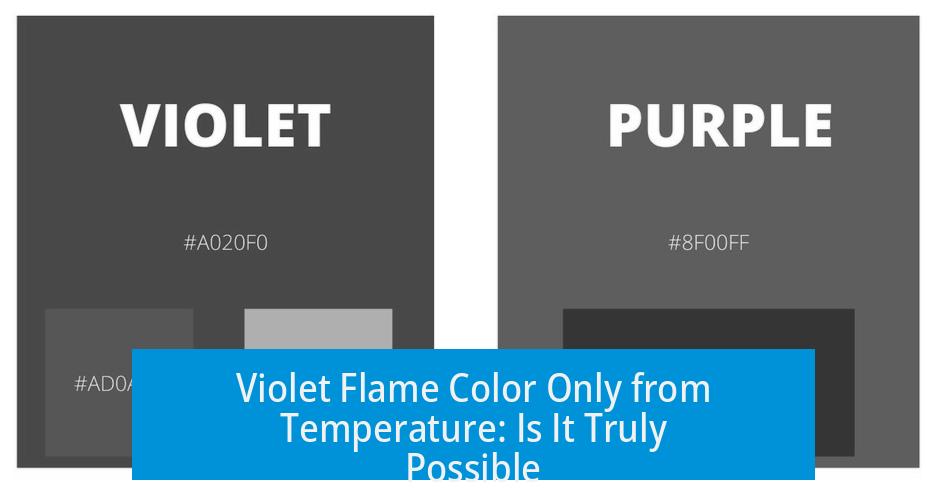Violet Flame Color with Only Temperature: Is It Possible?

Achieving a purely violet flame color by temperature alone is practically impossible. The human eye’s low sensitivity to violet light and the continuous nature of blackbody radiation prevent violet from appearing distinctly. Flame color depends mainly on chemical emissions, not temperature.
Understanding Flame Color and Temperature
When a flame burns, its color is often associated with temperature changes. This association comes from blackbody radiation, where the flame emits a broad spectrum of light whose peak shifts with temperature. However, this shift does not isolate specific colors like violet.
- Blackbody radiation produces a full, continuous spectrum.
- The spectrum peak shifts toward shorter wavelengths as temperature increases.
- At temperatures high enough to emit violet light (~390-410 nm), the flame emits light across the visible spectrum.
Because of this, a flame hot enough to emit violet wavelengths strongly also emits yellow, orange, and red light. Together, these colors mix and appear white or near-white to the human eye.
Human Eye Sensitivity to Violet Light

The sensitivity of the human eye decreases sharply in the violet range of 390-410 nanometers. This reduced sensitivity plays a major role in the invisibility of violet flames driven purely by temperature.
- Violet light falls near the edge of the visible spectrum, where human cones are less responsive.
- Even when violet wavelengths are present, the eye perceives the overall light color, dominated by stronger spectral components at longer wavelengths.
- Low violet sensitivity means violet light must be intense or isolated to be seen distinctly.
In high-temperature flames emitting violet light in the blackbody spectrum, the eye perceives a blend dominated by other colors, turning the flame white rather than violet.
Chemical Emission Determines Flame Color
Flame color arises mainly from the chemical species in the combustion gases. When molecules and radicals emit light at distinct wavelengths due to electronic transitions, the visible color changes.
| Flame Color | Origin | Example |
|---|---|---|
| Blue | Excited CH radicals and other species | Burning methane |
| Yellow/Orange | Incandescent soot particles (blackbody radiation) | Candle flame |
| Green | Excited copper atoms | Burning copper salts |
| Violet/Purple | Molecular emissions or specific metal ions | No common fuel; seen in electric arcs |
The blue flame in common lighters, for example, results from excited CH radicals from methane combustion, a chemical effect unrelated directly to temperature. Different fuels release different chemical species that emit characteristic colors.
Limitations of Blackbody Radiation in Producing Violet Flames

Blackbody radiation is temperature-driven emission with a continuous spectrum extending over visible wavelengths. However, it cannot produce a flame that appears purely violet.
- The blackbody curve broadens at high temperatures, spanning violet through red wavelengths.
- The relative intensity of violet wavelengths increases but does so alongside other colors.
- Consequently, the flame appears white or blue-white instead of violet.
- Filtering out all wavelengths except violet is necessary to perceive pure violet emission, which natural blackbody flames do not achieve.
Electric Arcs: An Alternative Violet Light Source
Violet or purple glowing light can appear in electric arcs, such as those generated by high voltage, low current devices. These arcs are not flames in the combustion sense but plasma discharge phenomena.
- Electric arcs produce hot plasma that emits discrete spectral lines including violet wavelengths.
- The light comes from atomic and ionic emissions in the plasma, not from blackbody radiation.
- The color can be intense and visibly violet or purple in the atmosphere.
This example highlights that pure violet hot light is not exclusive to flames but occurs in special non-flame, plasma conditions.
Fuel and Flame Temperature: Their Relationship to Color

Flame temperature and color correlate indirectly. Different fuels burn at varying temperatures and produce distinct chemical emissions.
- Fuel composition primarily determines flame chemical species and resultant spectral lines.
- Higher temperature can increase excitation and emissions intensities but does not control color alone.
- A violet flame cannot be induced simply by raising temperature but requires specific chemical species.
Thus, finding a flame with violet color involves selecting fuels or additives that produce violet-emitting species.
Why Pure Violet Flames Are Rare or Absent in Combustion
Several factors prevent pure violet flame colors naturally from combustion processes:
- Human Eye Factors: Low sensitivity to violet light masks the violet component.
- Chemistry: Few combustion species emit strong, isolated violet spectral lines.
- Blackbody Emission: Flames hot enough to emit violet blackbody radiation emit a broad full spectrum that blurs violet contributions.
- Incomplete Combustion: Soot and radicals cause yellow/orange emissions that overpower weak violet signals.
Only special chemical additives or non-flame sources like electric arcs show intense visible violet emissions clearly.
Key Takeaways
- Pure violet flame color from temperature alone does not occur because blackbody radiation covers all visible wavelengths and violet is weak.
- The human eye’s low sensitivity to violet wavelengths further limits violet flame perception.
- Flame colors originate mainly from chemical species emitting discrete spectral lines, not merely from thermal emission.
- Electric arcs can produce visible violet light at high temperatures but are not combustion flames.
- The relationship between flame temperature and color is indirect, influenced primarily by fuel chemistry.
Violet Flame Color with Only Temperature? Is This Possible?
Can temperature alone produce a visible violet flame? The straightforward answer: no. Let’s unravel why violet flames don’t simply roar out of hot fires, and what really makes flames flash in color.
We all picture flames in bright orange, yellow, or maybe blue. But violet? That elusive splash of purple is hard to nail down with heat alone. Does it sound surprising? Let’s dive in.
Why Temperature Falls Short in Creating Violet Flames
At first glance, it seems like cranking up the heat should naturally shift flame colors toward the violet end of the spectrum. After all, higher temperatures do shift emitted light to shorter wavelengths. This shift follows the well-known physics of blackbody radiation, where the hottest body glows differently than a cooler one. But here’s the catch:
- Blackbody radiation emits a broad range of colors simultaneously — it’s a full rainbow.
- When a flame gets hot enough to emit violet light (roughly 390-410 nm), the rest of the colors in the spectrum flood the eye too.
- The human eye’s sensitivity to violet light is weak compared to green, yellow, or red.
- Result? Instead of a neat violet flame, your eyes register a nearly white or pale flame.
In other words, the very heat needed to bump up visible violet light causes the entire spectrum to brighten — washing out the effect. To even glimpse violet from blackbody radiation, you’d need to carefully filter out all other wavelengths. That’s hardly the natural “flame” effect we picture.
Flame Colors Are More Chemistry Than Thermodynamics
Here’s a twist: much of the colors in flames don’t owe their hue to temperature alone. The flame’s chemistry plays the lead role. For instance, the familiar blue tip of a gas lighter flamethat’s not about reaching “blue temperatures.” Instead, it happens because of molecules like C-H bonds in methane burning.
These molecules undergo chemical reactions that emit light at specific wavelengths — producing unique colors. That’s why flame colors vary dramatically depending on:
- The kind of fuel burned
- The chemical radicals and intermediates formed
- How complete the combustion is
So, if you want a violet flame, just heating something hotter won’t cut it. You need the *right chemicals* burning to produce light in the violet spectral region.
Why You Rarely See Real Violet Flames in Nature
Burning common fuels like wood, gasoline, or natural gas rarely yields violets. Flame colors typically range from red to blue due to the chemicals formed. The so-called “fire rainbow” often seen in videos happens when chemicals or impurities are present, or with special compounds like potassium salts.
Potassium compounds can generate violet or purple flames—not because they are hotter, but because their atoms emit light in that color. But this violet hue arises from chemical emission lines, not blackbody radiation caused by heat.
Electric Arc: Nature’s (Non-Flame) Violet Glow
Looking for genuine hot purple light but don’t want to chase chemicals? Try watching an electric arc, like the spark from an e-cigarette lighter. These arcs shine bright violet or purple, but they are *not* flames nor blackbody radiation. Instead, they excite gas molecules electrically.
This violet glow is a vivid example of hot light that isn’t related to combustion at all. Electric arcs remind us that color and temperature are sometimes separate stories.
The Nuanced Link Between Flame Color, Fuel, and Temperature
The flame color often loosely corresponds to temperature because different fuels burn at different temperatures—and produce different chemicals. But:
- Higher temperature doesn’t cause violet flames by itself.
- The violet color depends on chemical species in the flame.
- You can find violet flames burning cooler fuels that have the right chemistry.
This flips the usual assumption that flame color directly measures temperature. It’s more complex: chemistry *and* temperature both matter—and chemistry often dictates the color palette.
So, Can You Burn a Violet Flame with Only Temperature?
In brief: no. The physics and human vision together block violet flames emerging from heat alone. The full blackbody emission spectrum dilutes the narrowly violet band, and our eyes are tuned to miss many violet wavelengths. To make a violet flame, you need chemistry to do the heavy lifting.
This doesn’t mean violet flames are impossible—it means they’re chemical, not just thermal. You can light fires colored violet by burning potassium salts or specialized chemicals. But cranking up temperature alone doesn’t cut it.
Practical Tips to See Violet Flames
- Try burning potassium salts (potassium chloride or potassium permanganate) safely in a controlled environment to get violet hues.
- If your goal is purely visual—look for electric arcs or discharge tubes producing violet glow.
- Use spectral filters to study flame components; this helps isolate the violet band.
- Remember: attempting extreme temperatures hoping for violet flames can be unsafe and futile without proper chemistry.
A Final Thought: Does Flame Color Measure Heat?
Next time you gaze at a campfire or a stove, ask yourself: is that flame color telling you the temperature? Not entirely. It’s mostly shouting the kind of stuff burning and how incomplete or chemical-rich the process is.
Violet flames are fascinating precisely because they’re rare and, with temperature alone, nearly invisible. They remind us of the messy chemistry behind the beautiful dance of fire.
Curious experimenters: don’t just turn up the thermostat—turn to the chemistry shelf and find the right ingredients for that mysterious violet glow!
Can temperature alone produce a visible violet flame?
No, temperature alone cannot produce a visible violet flame. High-temperature blackbody radiation contains violet light but appears white to the human eye due to the full spectrum emission.
Why do flames typically not show violet color despite their temperature?
The human eye is not very sensitive to violet light (390-410 nm). Flames hot enough to emit violet wavelengths also emit many other colors, mixing into white light overall.
Is flame color mostly due to temperature or chemical factors?
Flame color mainly comes from chemical emissions produced by molecules and radicals in the flame, not directly from temperature. Different fuels produce different colors.
Can violet color in flames be achieved by filtering light?
Yes, isolating violet light from a flame’s blackbody spectrum requires filtering out other wavelengths since blackbody radiation emits a full spectrum.
Are electric arcs examples of violet light from heat?
Yes, electric arcs produce hot, visible violet light but are not flames. Their light does not come from blackbody emission or combustion.





Leave a Comment